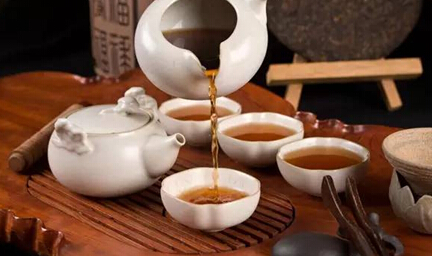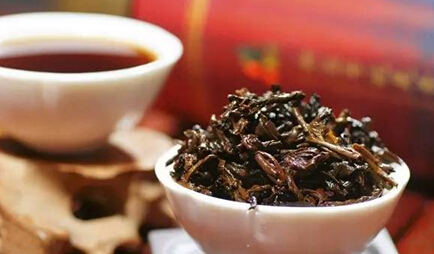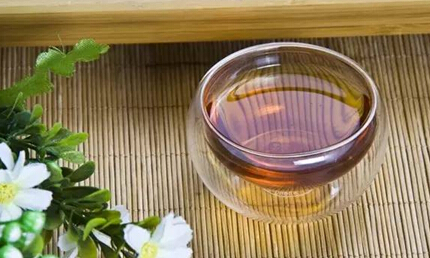Due to the similar reddish-brown liquor of ripe Pu-erh tea and black tea, many beginners often mistake ripe Pu-erh tea for black tea. In fact, Pu-erh tea and black tea are two entirely different types of tea products with fundamental differences.
【Main Text】1. Different Categories
Pu-erh tea belongs to the reprocessed tea category, while black tea is a basic tea type. Basic tea types include green tea, black tea, oolong tea, yellow tea, white tea, and dark tea. Black tea is one of them. Pu-erh tea, however, is made from sun-dried green tea leaves (a type of green tea) through a special processing technique.

2. Different Flavors and Aromas
Pu-erh tea has a mellow taste with a distinctive aged aroma, while black tea offers a sweet, refreshing taste with a fragrant sweetness. The aged aroma of Pu-erh tea and the sweet aroma of black tea are easy to distinguish.
3. Different Processing Techniques
Taking loose Pu-erh tea and Gongfu black tea as examples, the processing technique for loose Pu-erh tea is: Yunnan large-leaf sun-dried green tea → pile fermentation → drying → sieving → sorting → blending. The processing technique for Gongfu black tea is: fresh tea leaves → withering → rolling → fermentation → shaping → drying → crude black tea → refining → baking → finished product.
Among these, Yunnan large-leaf sun-dried green tea belongs to the green tea category, and its processing technique is: fresh leaves of Yunnan large-leaf tea trees → fixation → rolling → sun-drying.

4. Different Product Forms
Pu-erh tea products include loose Pu-erh tea and compressed Pu-erh tea. Loose Pu-erh tea has thick, tightly knotted strips with a brown or reddish-brown color. Compressed Pu-erh tea is made by steaming and pressing loose Pu-erh tea into shapes like cakes, bricks, or bowls.
Black tea products mainly include Gongfu black tea and broken black tea. Gongfu black tea is mostly strip-shaped, with some curled varieties, and has a dark, glossy appearance with golden tips. Broken black tea comes in small granular forms with a dark, glossy color and can be further processed into tea bags.
Additionally, Pu-erh tea is a geographically protected product unique to Yunnan and must be made from Yunnan large-leaf sun-dried green tea. Black tea, however, can be made from both large-leaf and small-leaf tea varieties, such as "Dianhong" (made from large-leaf tea) and "Qihong" (made from small-leaf tea).
1. Black tea is fully fermented, while Pu-erh tea is post-fermented. Black tea is best when fresh, while Pu-erh tea improves with age (within a certain range).
2. Pu-erh tea is divided into raw and ripe varieties. Raw Pu-erh tea is sun-dried green tea made from Yunnan large-leaf tea, while ripe Pu-erh tea is formed through aging and post-fermentation. Black tea is divided into small-leaf black tea, Gongfu black tea, and broken black tea. Domestic Gongfu black tea includes Qihong, Dianhong, Minhong, Chuanhong, Yihong, and Haihong. The world's first black tea, Lapsang Souchong, is a small-leaf black tea, while broken black tea is more common abroad.
Black tea has a natural sweetness, while Pu-erh tea has an aged aroma, each with its own unique characteristics. Both black tea and ripe Pu-erh tea are stomach-friendly and are especially suitable for drinking in winter.
3. In terms of appearance, Dianhong black tea is mainly loose tea, while Pu-erh tea is mostly compressed.

4. In terms of processing, black tea is pre-fermented, meaning fermentation stops after production. Pu-erh tea, however, is post-fermented and continues to undergo natural fermentation during storage, even if it is artificially fermented ripe tea. Therefore, Pu-erh tea has raw and ripe varieties, while black tea does not.
5. Pu-erh tea must be made from Yunnan large-leaf tea, while black tea has no such requirement, at least not limited to Yunnan large-leaf tea.
6. During the post-fermentation of Pu-erh tea, highly stimulating substances like polyphenols are significantly reduced, and the tea develops a smooth, sticky texture that forms a protective layer in the stomach. Black tea undergoes enzymatic oxidation, reducing and transforming polyphenols, thereby lessening stomach irritation. Its oxidation products aid digestion, reduce inflammation, and protect the stomach lining, providing a soothing effect.